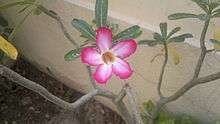Adenium obesum
| Desert rose | |
|---|---|
| | |
| Scientific classification | |
| Kingdom: | Plantae |
| (unranked): | Angiosperms |
| (unranked): | Eudicots |
| (unranked): | Asterids |
| Order: | Gentianales |
| Family: | Apocynaceae |
| Genus: | Adenium |
| Species: | A. obesum |
| Binomial name | |
| Adenium obesum (Forssk.) Roem. & Schult. | |
| Subspecies | |
|
See text. | |
| Synonyms | |
|
Adenium coetaneum Stapf | |
Adenium obesum is a species of flowering plant in the dogbane family, Apocynaceae, that is native to the Sahel regions, south of the Sahara (from Mauritania and Senegal to Sudan), and tropical and subtropical eastern and southern Africa and Arabia. Common names include Sabi star, kudu, mock azalea, impala lily and desert rose.

Description
It is an evergreen or drought-deciduous succulent shrub (which can also lose its leaves during cold spells, or according to the subspecies or cultivar). It can grow to 1–3 m (3.3–9.8 ft) in height, with pachycaul stems and a stout, swollen basal caudex. The leaves are spirally arranged, clustered toward the tips of the shoots, simple entire, leathery in texture, 5–15 cm (2.0–5.9 in) long and 1–8 cm (0.39–3.15 in) broad. The flowers are tubular, 2–5 cm (0.79–1.97 in) long, with the outer portion 4–6 cm (1.6–2.4 in) diameter with five petals, resembling those of other related genera such as Plumeria and Nerium. The flowers tend to red and pink, often with a whitish blush outward of the throat.


Taxonomy
Some taxonomies consider some other species in the genus to be subspecies of Adenium obesum.
Subspecies
- Adenium obesum subsp. obesum (Mauritania and Senegal to Sudan)
- Adenium obesum subsp. oleifolium (South Africa, Botswana)
- Adenium obesum subsp. socotranum (Socotra)
- Adenium obesum subsp. somalense (Eastern Africa)
- Adenium obesum subsp. swazicum (Swaziland, South Africa)
Uses
Adenium obesum produces a sap in its roots and stems that contains cardiac glycosides. This sap is used as arrow poison for hunting large game throughout much of Africa[2] and as a fish toxin.[3]
Cultivation
Adenium obesum is a popular houseplant and bonsai[4] in temperate regions. It requires a sunny location and a minimum indoor temperature in winter of 10 °C (50 °F). It thrives on a xeric watering regime as required by cacti. A. obesum is typically propagated by seed or stem cuttings. The numerous hybrids are propagated mainly by grafting on to seedling rootstock. While plants grown from seed are more likely to have the swollen caudex at a young age, with time many cutting-grown plants cannot be distinguished from seedlings. Like many plants, Adenium obesum can also be propagated in vitro using plant tissue culture.[5]
This plant has gained the Royal Horticultural Society's Award of Garden Merit.[6]
Symbolic and cultural references
The species has been depicted on postage stamps issued by various countries.[7]
Gallery
References
- ↑ "Taxon: Adenium obesum (Forssk.) Roem. & Schult.". Germplasm Resources Information Network. United States Department of Agriculture. 1997-05-22. Retrieved 2010-09-30.
- ↑ Schmelzer, G.H.; A. Gurib-Fakim (2008). Medicinal Plants. Plant Resources of Tropical Africa. pp. 46–49. ISBN 978-90-5782-204-9.
- ↑ John 'Lofty' Wiseman SAS Survival Handbook, Revised Edition p. 240; William Morrow Paperbacks (2009) ISBN 978-1875900060
- ↑ D'Cruz, Mark. "Ma-Ke Bonsai Care Guide for Adenium obesum". Ma-Ke Bonsai. Retrieved 2011-05-11.
- ↑ Kanchanapoom, Kantamaht; Sunheem, Sunisa; Kanchanapoom, Kamnoon (5 December 2010). "In vitro Propagation of Adenium obesum (Forssk.) Roem. and Schult.". Notulae Botanicae Horti Agrobotanici Cluj-Napoca. 38 (3): 209–213. doi:10.15835/nbha3834604. ISSN 1842-4309. Retrieved 26 January 2016.
- ↑ "RHS Plant Selector - Adenium obesum". Retrieved 7 July 2013.
- ↑ "Stamps, Adenium obesum design". StampData. Retrieved 27 January 2016.
External links
- Adenium obesum on the PLANTS Profile of the USDA Natural Resources Conservation Service
- Adenium obesum in West African plants – A Photo Guide.
| Wikimedia Commons has media related to Adenium obesum. |
| External identifiers for Adenium obesum | |
|---|---|
| Encyclopedia of Life | 5328452 |
| ITIS | 893830 |
| NCBI | 69375 |
| Also found in: Wikispecies | |
_1200.jpg)
_1200.jpg)